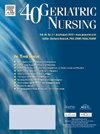诸如肌肉减少症、虚弱和内在能力下降等并发症与稳定型精神分裂症患者的跌倒有关
IF 2.4
3区 医学
Q3 GERIATRICS & GERONTOLOGY
引用次数: 0
摘要
目的:跌倒对健康有重大影响,是精神病患者常见的并发症。研究表明跌倒与肌肉减少症、虚弱和内在能力(IC)下降有关。然而,这些关系尚未在精神分裂症患者中进行调查。在这里,我们的目的是评估肌肉减少症、虚弱和IC降低作为稳定型精神分裂症患者跌倒的预测因素的作用。设计:回顾性队列研究。环境和参与者:本研究包括中国西部两家精神卫生中心诊断为精神分裂症的住院患者。纳入标准为50岁及以上的住院患者以及常规服用抗精神病药物的患者。通过与患者面对面访谈获得基本信息。骨骼肌减少症是根据2019年亚洲骨骼肌减少症工作组(AWGS)定义的诊断标准诊断的。虚弱度采用体弱量表测量,IC通过认知、心理、感觉功能、活力和运动五个特征的评估来评估。结果指标是过去一年的跌倒次数,是通过查阅医疗记录和询问患者和医务人员获得的。采用logistic回归分析骨骼肌减少症、虚弱、IC与跌倒的相关性。结果339例诊断为稳定型精神分裂症的患者纳入研究,平均年龄65岁,其中232例(68.44%)为男性。其中55个(16.22%)报告在过去一年中有所下降。诊断为肌肉减少和虚弱的患者分别为180例(53.10%)和47例(13.86%)。诊断为IC下降的321例,其中1、2、3、4、5个维度受损的分别为130例(40.50%)、73例(22.74%)、68例(21.18%)、44例(13.71%)、6例(1.87%)。有肌肉减少症和虚弱的患者跌倒发生率高于无肌肉减少症的患者(21.67% vs 10.06%, P = 0.004;虚弱:31.91% vs 13.7%, P = 0.002)。跌倒组的IC评分明显高于未跌倒组(P = 0.001)。在对可能的混杂变量进行校正后,logistic回归分析显示,与没有肌肉减少症的患者相比,肌肉减少症和虚弱的患者摔倒的可能性增加(OR = 3.24, 95% CI: 1.18-8.88;脆弱性:OR = 1.46, 95% CI: 1.14-1.87)。还证实,较高的IC评分与较高的跌倒风险相关(OR = 1.42, 95% CI: 1.08-1.88)。结论:研究结果表明,肌肉减少症、虚弱和IC降低等并发症与稳定型精神分裂症患者的跌倒有关,这些情况在这一人群中很常见。建议临床医生和医务人员在患者管理中意识到这些关联。本文章由计算机程序翻译,如有差异,请以英文原文为准。
Complications such as sarcopenia, frailty, and decreased intrinsic capacity are associated with falls in patients with stable schizophrenia
Objective
Falls have significant health consequences and are a common complication in psychiatric patients. Studies have shown associations of falls with sarcopenia, frailty, and decreased intrinsic capacity (IC). However, these relationships have not been investigated in schizophrenia patients. Here, we aim to the assessment of the role of sarcopenia, frailty, and decreased IC as predictors of falls in patients with stable schizophrenia.
Measurements
Design: Retrospective cohort study. Setting and Participants: The study included inpatients diagnosed with schizophrenia from two mental health centers in Western China. The inclusion criteria were inpatients aged 50 years and over as well as those on regular neuroleptic medication. Basic information was obtained through face-to-face interviews with the patients. Sarcopenia was diagnosed following the diagnostic criteria, defined by the Asian Working Group for Sarcopenia (AWGS) 2019. Frailty was measured by the FRAIL scale, while IC was evaluated through assessment of five characteristics: cognition, psychological, sensory function, vitality and locomotion. The outcome indicator was the number of falls in the past year, obtained by consulting the medical records and interrogating the patients and medical staff. The correlation between sarcopenia, frailty, IC and falls was analyzed by logistic regression analysis.
Results
339 patients diagnosed with stable schizophrenia were recruited in the study, with a mean age of 65 years among who 232 (68.44 %) were males. 55 (16.22 %) of them reported falls in the past year. Patients diagnosed with sarcopenia and frailty were 180 (53.10 %) and 47 (13.86 %), respectively. 321 were diagnosed with IC decline, of which 130 (40.50 %), 73 (22.74 %), 68 (21.18 %), 44 (13.71 %) and 6 (1.87 %) were impaired in one, two, three, four, and five dimensions, respectively. Patients with sarcopenia and frailty had a higher incidence of falls than those without (sarcopenia: 21.67 % vs 10.06 %, P = 0.004; frailty: 31.91 % vs 13.7 %, P = 0.002). The IC score of the fall group was significantly higher than that in the non-fall group (P = 0.001). After adjustment for possible confounding variables, logistic regression analysis showed that patients with sarcopenia and frailty had an increased likelihood of falls compared with those without (sarcopenia: OR = 3.24, 95 % CI: 1.18–8.88; frailty: OR = 1.46, 95 %CI: 1.14–1.87). It was also confirmed that higher IC scores were associated with a greater risk of falling (OR = 1.42, 95 %CI: 1.08–1.88).
Conclusions
The findings showed that complications such as sarcopenia, frailty, and decreased IC were associated with falls in patients with stable schizophrenia, and that these conditions are common in this populations. It is recommended that clinicians and medical personnel be aware of these associations in patient management.
求助全文
通过发布文献求助,成功后即可免费获取论文全文。
去求助
来源期刊

Geriatric Nursing
医学-护理
CiteScore
3.80
自引率
7.40%
发文量
257
审稿时长
>12 weeks
期刊介绍:
Geriatric Nursing is a comprehensive source for clinical information and management advice relating to the care of older adults. The journal''s peer-reviewed articles report the latest developments in the management of acute and chronic disorders and provide practical advice on care of older adults across the long term continuum. Geriatric Nursing addresses current issues related to drugs, advance directives, staff development and management, legal issues, client and caregiver education, infection control, and other topics. The journal is written specifically for nurses and nurse practitioners who work with older adults in any care setting.
 求助内容:
求助内容: 应助结果提醒方式:
应助结果提醒方式:


